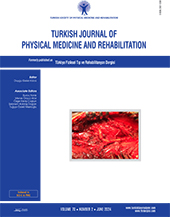Adiponectin in spinal cord injury: What is the role of nutrition in serum adiponectin concentration?
2 Department of Nutrition and Dietetics, University of Health Sciences Türkiye, Gülhane Health Sciences Faculty, Ankara, Türkiye
3 Department of Nutrition and Dietetics, Izmir Katip Çelebi University, Faculty of Health Sciences, Izmir, Türkiye
4 Department of Physical Medicine and Rehabilitation, Karabük University School of Medicine, Karabük, Türkiye DOI : 10.5606/tftrd.2024.13946 Objectives: The study aimed to analyze the relationship between serum adiponectin concentration, Mediterranean diet (MD) adherence, and Dietary Approaches to Stop Hypertension (DASH) diet adherence in patients with spinal cord injury (SCI).
Patients and methods: Thirty-three SCI patients (21 males, 12 females; median age: 33 years; range, 18 to 65 years) and 33 age-, sex-, and body mass index-matched healthy controls (21 males, 12 females; median age: 33 years; range, 18 to 64 years) were included in this crosssectional study between March 2021 and March 2022. Serum adiponectin concentrations of all participants were measured. Body weight, height, and neck, hip, waist, and mid-upper arm circumferences were measured. Twenty-four-hour dietary records were obtained by the researchers for evaluation of the nutritional status. The DASH diet score and MD score were measured for each participant.
Results: Most of the cases of SCI were due to motor vehicle collisions (n=12, 36.4%) and complete paraplegic. Mid-upper arm circumference, waist circumference, hip circumference, and neck circumference of the patient group were significantly higher than the control group (p=0.020, p=0.002, p=0.042, and p<0.001, respectively). Mediterranean diet scores and DASH diet scores of the patient group were significantly higher than the control group (p<0.001 and p=0.031, respectively). Serum adiponectin concentration of patients was significantly higher than the control group (p=0.049). No correlation was detected between adiponectin concentration, MD score, and DASH diet score in both groups.
Conclusion: Although correlation analysis in the current research did not show significant relation between nutrition and adiponectin concentrations, nutrition of patients with SCI, as demonstrated by higher adherence to MD and DASH, may have provided positive effects on adiponectin concentrations. Future studies focused on the effect of a healthy diet intervention on serum adiponectin concentration is warranted.
Keywords : Adiponectin, diet, nutrition, spinal cord injuries

















